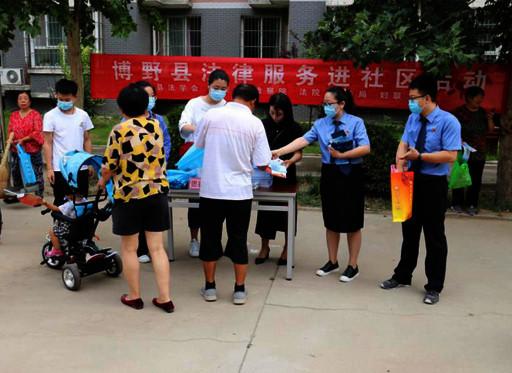
. > WHAT'S NEW > CONFERENCES
Webinar explores innovation in social governance
Author : ZHANG JIE and ZHU YI Source : Chinese Social Sciences Today 2021-01-18

Legal consultancy services are provided for residents at a community in Boye County, Hebei Province, July 2, 2020. Photo: BDWM
At a webinar on social governance on Dec. 19, 2020, scholars exchanged views on a wide range of topics related to governance, from the Belt and Road (B&R) and global governance, migration and community governance, to resource utilization and ecological environment governance.
Urban and rural governance is a major focus in this period of China’s social transformation, said Ye Chao, a professor from the School of Geographic Sciences at East China Normal University. Innovative governance thinking and models are particularly needed as China’s urban and rural governance is faced with international and domestic challenges. Governance research is a hot topic not only in the fields of management, sociology, economics, and other social sciences, but also in ecology and geography, which requires interdisciplinary integration.
B&R construction plays a part in enriching global governance practices, said Xiangming Chen, a professor of global urban studies and sociology at Trinity College in Hartford, Connecticut. B&R construction is of great significance to regionalization, economic globalization, urbanization, and economic development. Connecting the globe, regions, and cities, the B&R will promote a major transformation of economic globalization. In other words, the B&R can truly link countries and regions through infrastructure construction, realizing a diverse connection and cooperative development between China and its neighboring countries and regions. B&R construction serves as a bridge for economic globalization, which will profoundly affect global governance.
Large-scale internal or international population migration and mobility are a hot topic in the field of social governance, said Zhu Hong, director of the Center for Human Geography and Urban Development at Guangzhou University. More attention should be paid to the micro analysis, lifestyles, and daily lives of immigrants. As an emerging research field, it involves social governance and institutional innovation, which demands more humanistic and diversified research.
Communities are the most basic “cells” of urban and rural spaces. Attention has been paid to building safe, convenient, and healthy community life circles that meet the needs of new lifestyles and production modes. Urban planning in the new era should return to “daily life,” moving from being production-space-oriented to living-space-oriented, from objects to people, from scale to structure, from static to dynamic, and from management to governance, suggested Chai Yanwei, director of the Center for Research and Planning of Smart Cities at Peking University.
We need to explore new paths for coordinated urban and rural governance, aiming at the integrated development of urban and rural areas, said Chen Ruishan, a professor from the School of Geographic Sciences at East China Normal University. For example, a sustainable governance model should be applied when dealing with practical problems, institutional dilemmas, and the sustainable governance of China’s natural resource use. We should modernize governance capacity and realize the linkage of multidimensional systems for resource utilization. Meanwhile, we should uphold multi-agent governance, encouraging the participation of multiple entities in governance, such as governments, rural people, markets, and society. In addition, transitions should be made from single-factor to total-factor governance to highlight multicenter governance and the network linkage of regions, dimensions, and factors, thus achieving collaborative governance.
Ma Libang, dean of the College of Geography and Environmental Science at Northwest Normal University, proposed new paths for Gansu Province’s urbanrural governance and integrated development in the new era. At the macro level, we should fully leverage the important position and demonstrative effect of Gansu’s urban-rural development within the Western Development Strategy, opening up a differentiated path for the urbanrural development of western China. At the meso level, we should explore diversified urban-rural integrated development models based on regional differences in Gansu’s urban-rural development, facilitating more efficient resource allocation and the flow of production factors. At the micro level, we should fully activate the role of multiple stakeholders in the process of urban and rural governance, and encourage institutional innovation at the primary level, building and innovating with a governance model centered on urban and rural communities.
Community life needs new theories and methodological guidance, Chai added. We can regard community life circles as local spaces of order and examine their dynamic changes from the dimensions of daily life and living experiences. Meanwhile, efforts should be made to develop high-precision behavior data collection technology, analysis and visualization technology, and simulation and prediction technology, providing technical support for research on community life circles. In addition, innovation is necessary when researching the planning of community life circles, to accommodate the connotations of community life circles and lead the studies of Chinese cities and communities.
Ye Shengtao made Chinese fairy tales from a wilderness
Ye Shengtao (1894–1988) created the first collection of fairy tales in the history of Chinese children’s literature...
-
How northern ethnicities integrated into Chinese nation
2023-09-18
-
Mogao caves
2023-09-12
-
Mogao Grottoes as ‘a place of pilgrimage’
2023-09-12
-
Time-honored architectural traditions in China
2023-08-29
-
Disentangling the civilizational evolution of China
2023-08-28
-
AI ethics in science fiction
2023-08-23













 2011-2013 by www.cssn.cn. All Rights Reserved
2011-2013 by www.cssn.cn. All Rights Reserved